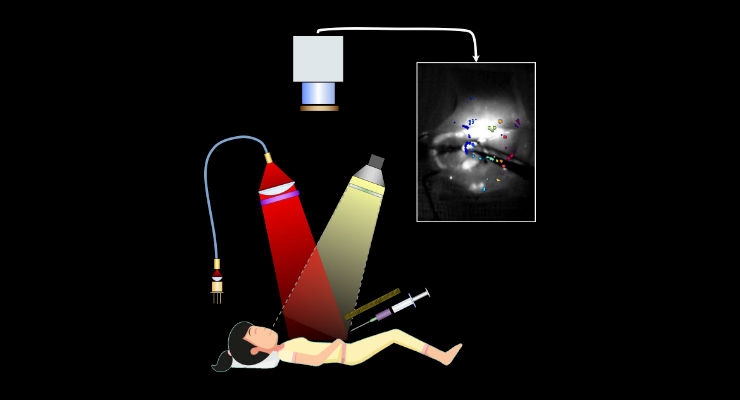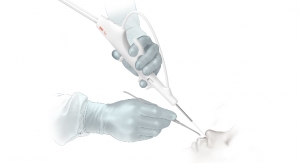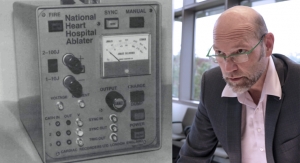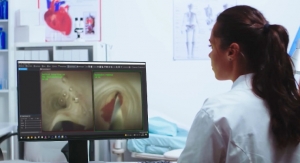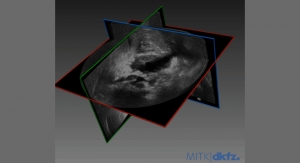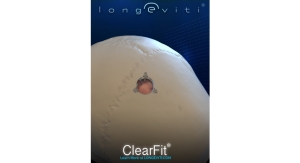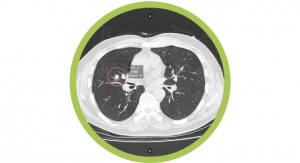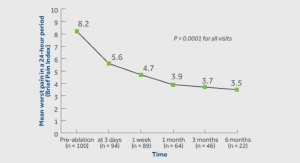Anne Trafton, MIT News Office04.24.19
Ovarian cancer is usually diagnosed only after it has reached an advanced stage, with many tumors spread throughout the abdomen. Most patients undergo surgery to remove as many of these tumors as possible, but because some are so small and widespread, it is difficult to eradicate all of them.
Researchers at MIT, working with surgeons and oncologists at Massachusetts General Hospital (MGH), have now developed a way to improve the accuracy of this surgery, called debulking. Using a novel fluorescence imaging system, they were able to find and remove tumors as small as 0.3 millimeters—smaller than a poppy seed—during surgery in mice. Mice that underwent this type of image-guided surgery survived 40 percent longer than those who had tumors removed without the guided system.
“What’s nice about this system is that it allows for real-time information about the size, depth, and distribution of tumors,” said Angela Belcher, the James Mason Crafts Professor of Biological Engineering and Materials Science at MIT, a member of the Koch Institute for Integrative Cancer Research, and the recently appointed head of MIT’s Department of Biological Engineering.
The researchers are now seeking FDA approval for a phase 1 clinical trial to test the imaging system in human patients. In the future, they hope to adapt the system for monitoring patients at risk for tumor recurrence, and eventually for early diagnosis of ovarian cancer, which is easier to treat if it is caught earlier.
Belcher and Michael Birrer, formerly the director of medical gynecologic oncology at MGH and now the director of the O’Neal Comprehensive Cancer Center at the University of Alabama at Birmingham, are the senior authors of the study, published online in the journal ACS Nano this week.
Neelkanth Bardhan, a Mazumdar-Shaw International Oncology Fellow at the Koch Institute, and Lorenzo Ceppi, a researcher at MGH, are the lead authors of the paper. Other authors include MGH researcher YoungJeong Na, MIT Lincoln Laboratory technical staff members Andrew Siegel and Nandini Rajan, Robert Fruscio of the University of Milan-Bicocca, and Marcela del Carmen, a gynecologic oncologist at MGH and chief medical officer of the Massachusetts General Physicians Organization.
Glowing Tumors
Because there is no good way to detect early-stage ovarian cancer, it is one of the most difficult types of cancer to treat. Of 250,000 new cases diagnosed each year worldwide, 75 percent are in an advanced stage. In the United States, the five-year combined survival rate for all stages of ovarian cancer is 47 percent, only a slight improvement from 38 percent three decades ago, despite the advent of chemotherapeutic drugs such as cisplatin, approved by the FDA in 1978 for ovarian cancer treatment. In contrast, the five-year combined survival rate for all stages of breast cancer has steadily improved, from around 75 percent in the 1970s to over 90 percent now.
“We desperately need better upfront therapies, including surgery, for these (ovarian cancer) patients,” Birrer said.
Belcher and Birrer joined forces to work on this problem through the Bridge Project, a collaboration between the Koch Institute and Dana-Farber/Harvard Cancer Center. Belcher’s lab has been developing a novel type of medical imaging based on light in the near-infrared (NIR) spectrum. In a paper published in March, she reported that this imaging system could achieve an unprecedented combination of resolution and penetration-depth in living tissue.
In the new study, Belcher, Birrer, and their colleagues worked with researchers at MIT Lincoln Laboratory to adapt NIR imaging to help surgeons locate tumors during ovarian cancer surgery, by providing continuous, real-time imaging of the abdomen, with tumors highlighted by fluorescence. Previous analyses have shown that survival rates are strongly inversely correlated with the amount of residual tumor mass left behind in the patient during debulking surgery, but many ovarian tumors are so small or hidden that surgeons can’t find them.
To make the tumors visible, the researchers designed chemical probes using single-walled carbon nanotubes that emit fluorescent light when illuminated by a laser. They coated these nanotubes with a peptide that binds to SPARC, a protein that is overexpressed by highly invasive ovarian cancer cells. This probe binds to the tumors and makes them fluoresce at NIR wavelengths, allowing surgeons to more easily find them with fluorescence imaging.
The researchers tested the image-guided system in mice that had ovarian tumors implanted in a region of the abdominal cavity known as the intraperitoneal space, and showed that surgeons were able to locate and remove tumors as small as 0.3 millimeters. Ten days after surgery, these mice had no detectable tumors, while mice that had undergone the traditional, non-image-guided surgery, had many residual tumors missed by the surgeon.
By three weeks after the surgery, many of the tumors had grown back in the mice that underwent image-guided surgery, but those mice still had a median survival rate that was 40 percent longer than that of mice that underwent traditional surgery.
No other imaging system would be able to locate tumors that small during a surgical procedure, the researchers said.
“You can’t have a patient in a CT machine or an MRI machine and have the surgeon perform this surgical debulking procedure at the same time, and you can’t expose the patient to X-ray radiation for multiple hours of the long surgery. This optics-based imaging system allows us to do that in a safe manner,” Bardhan said.
Alessandro Santin, a professor of obstetrics and gynecology and clinical research program leader at the Yale University School of Medicine, described the results as “intriguing.”
“These data support the potential use of this novel imaging system in the intraoperative setting for the optical detection of residual malignant tissue at the time of surgical staging, and/or cytoreductive surgery in ovarian cancer patients,” said Santin, who was not involved in the study.
Monitoring Patients
For most ovarian cancer patients, tumor debulking surgery is followed by chemotherapy, so the researchers now plan to do another study where they treat the mice with chemotherapy after image-guided surgery, in hopes of preventing the remaining tiny tumors from spreading.
“We know that the amount of tumor removed at the time of surgery for patients with advanced-stage ovarian cancer is directly correlated with their outcome,” Birrer said. “This imaging device will now allow the surgeon to go beyond the limits of resecting tumors visible to the naked eye, and should usher in a new age of effective debulking surgery.”
Now that they have demonstrated that this concept can be successfully applied to imaging during surgery, the researchers hope to begin adapting the system for use in human patients.
“In principle, it’s quite doable,” Siegel said. “It’s purely the mechanics and the funding at this point, because this mouse experiment serves as the proof of principle and may actually have been more challenging than building a human-scale system.”
The researchers also hope to deploy this type of imaging to monitor patients after surgery, and eventually to develop it as a diagnostic tool for screening women at high risk for developing ovarian cancer.
“A major focus for us right now is developing the technology to be able diagnose ovarian cancer early, in stage 1 or stage 2, before the disease becomes disseminated,” Belcher said. “That could have a huge impact on survival rates, because survival is related to the stage of detection.”
The research was funded, in part, by the Bridge Project and the Koch Institute Support (core) Grant from the National Cancer Institute, with previous support for the development of the system from the Koch Institute Frontier Research Program and the Kathy and Curt Marble Cancer Research Fund.
Researchers at MIT, working with surgeons and oncologists at Massachusetts General Hospital (MGH), have now developed a way to improve the accuracy of this surgery, called debulking. Using a novel fluorescence imaging system, they were able to find and remove tumors as small as 0.3 millimeters—smaller than a poppy seed—during surgery in mice. Mice that underwent this type of image-guided surgery survived 40 percent longer than those who had tumors removed without the guided system.
“What’s nice about this system is that it allows for real-time information about the size, depth, and distribution of tumors,” said Angela Belcher, the James Mason Crafts Professor of Biological Engineering and Materials Science at MIT, a member of the Koch Institute for Integrative Cancer Research, and the recently appointed head of MIT’s Department of Biological Engineering.
The researchers are now seeking FDA approval for a phase 1 clinical trial to test the imaging system in human patients. In the future, they hope to adapt the system for monitoring patients at risk for tumor recurrence, and eventually for early diagnosis of ovarian cancer, which is easier to treat if it is caught earlier.
Belcher and Michael Birrer, formerly the director of medical gynecologic oncology at MGH and now the director of the O’Neal Comprehensive Cancer Center at the University of Alabama at Birmingham, are the senior authors of the study, published online in the journal ACS Nano this week.
Neelkanth Bardhan, a Mazumdar-Shaw International Oncology Fellow at the Koch Institute, and Lorenzo Ceppi, a researcher at MGH, are the lead authors of the paper. Other authors include MGH researcher YoungJeong Na, MIT Lincoln Laboratory technical staff members Andrew Siegel and Nandini Rajan, Robert Fruscio of the University of Milan-Bicocca, and Marcela del Carmen, a gynecologic oncologist at MGH and chief medical officer of the Massachusetts General Physicians Organization.
Glowing Tumors
Because there is no good way to detect early-stage ovarian cancer, it is one of the most difficult types of cancer to treat. Of 250,000 new cases diagnosed each year worldwide, 75 percent are in an advanced stage. In the United States, the five-year combined survival rate for all stages of ovarian cancer is 47 percent, only a slight improvement from 38 percent three decades ago, despite the advent of chemotherapeutic drugs such as cisplatin, approved by the FDA in 1978 for ovarian cancer treatment. In contrast, the five-year combined survival rate for all stages of breast cancer has steadily improved, from around 75 percent in the 1970s to over 90 percent now.
“We desperately need better upfront therapies, including surgery, for these (ovarian cancer) patients,” Birrer said.
Belcher and Birrer joined forces to work on this problem through the Bridge Project, a collaboration between the Koch Institute and Dana-Farber/Harvard Cancer Center. Belcher’s lab has been developing a novel type of medical imaging based on light in the near-infrared (NIR) spectrum. In a paper published in March, she reported that this imaging system could achieve an unprecedented combination of resolution and penetration-depth in living tissue.
In the new study, Belcher, Birrer, and their colleagues worked with researchers at MIT Lincoln Laboratory to adapt NIR imaging to help surgeons locate tumors during ovarian cancer surgery, by providing continuous, real-time imaging of the abdomen, with tumors highlighted by fluorescence. Previous analyses have shown that survival rates are strongly inversely correlated with the amount of residual tumor mass left behind in the patient during debulking surgery, but many ovarian tumors are so small or hidden that surgeons can’t find them.
To make the tumors visible, the researchers designed chemical probes using single-walled carbon nanotubes that emit fluorescent light when illuminated by a laser. They coated these nanotubes with a peptide that binds to SPARC, a protein that is overexpressed by highly invasive ovarian cancer cells. This probe binds to the tumors and makes them fluoresce at NIR wavelengths, allowing surgeons to more easily find them with fluorescence imaging.
The researchers tested the image-guided system in mice that had ovarian tumors implanted in a region of the abdominal cavity known as the intraperitoneal space, and showed that surgeons were able to locate and remove tumors as small as 0.3 millimeters. Ten days after surgery, these mice had no detectable tumors, while mice that had undergone the traditional, non-image-guided surgery, had many residual tumors missed by the surgeon.
By three weeks after the surgery, many of the tumors had grown back in the mice that underwent image-guided surgery, but those mice still had a median survival rate that was 40 percent longer than that of mice that underwent traditional surgery.
No other imaging system would be able to locate tumors that small during a surgical procedure, the researchers said.
“You can’t have a patient in a CT machine or an MRI machine and have the surgeon perform this surgical debulking procedure at the same time, and you can’t expose the patient to X-ray radiation for multiple hours of the long surgery. This optics-based imaging system allows us to do that in a safe manner,” Bardhan said.
Alessandro Santin, a professor of obstetrics and gynecology and clinical research program leader at the Yale University School of Medicine, described the results as “intriguing.”
“These data support the potential use of this novel imaging system in the intraoperative setting for the optical detection of residual malignant tissue at the time of surgical staging, and/or cytoreductive surgery in ovarian cancer patients,” said Santin, who was not involved in the study.
Monitoring Patients
For most ovarian cancer patients, tumor debulking surgery is followed by chemotherapy, so the researchers now plan to do another study where they treat the mice with chemotherapy after image-guided surgery, in hopes of preventing the remaining tiny tumors from spreading.
“We know that the amount of tumor removed at the time of surgery for patients with advanced-stage ovarian cancer is directly correlated with their outcome,” Birrer said. “This imaging device will now allow the surgeon to go beyond the limits of resecting tumors visible to the naked eye, and should usher in a new age of effective debulking surgery.”
Now that they have demonstrated that this concept can be successfully applied to imaging during surgery, the researchers hope to begin adapting the system for use in human patients.
“In principle, it’s quite doable,” Siegel said. “It’s purely the mechanics and the funding at this point, because this mouse experiment serves as the proof of principle and may actually have been more challenging than building a human-scale system.”
The researchers also hope to deploy this type of imaging to monitor patients after surgery, and eventually to develop it as a diagnostic tool for screening women at high risk for developing ovarian cancer.
“A major focus for us right now is developing the technology to be able diagnose ovarian cancer early, in stage 1 or stage 2, before the disease becomes disseminated,” Belcher said. “That could have a huge impact on survival rates, because survival is related to the stage of detection.”
The research was funded, in part, by the Bridge Project and the Koch Institute Support (core) Grant from the National Cancer Institute, with previous support for the development of the system from the Koch Institute Frontier Research Program and the Kathy and Curt Marble Cancer Research Fund.

